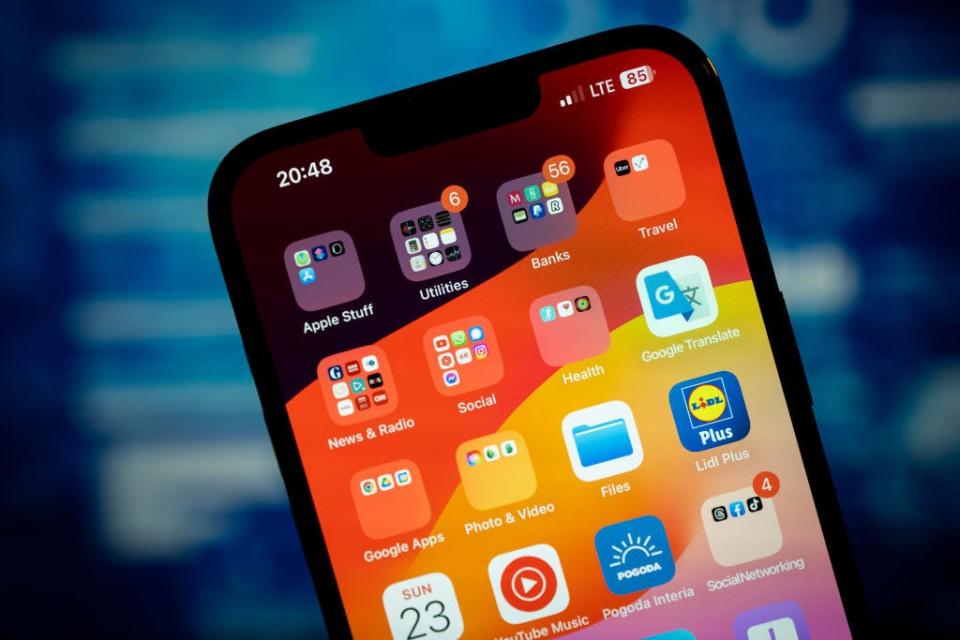Federal regulators are wielding a classic Warren Buffett concept to go after Apple — his biggest stock bet
-
The Department of Justice is suing Apple for monopolizing smartphone markets with the iPhone.
-
Regulators called Apple’s defenses against its rivals a “moat,” borrowing Warren Buffett‘s metaphor.
-
Buffett’s Berkshire Hathaway is one of Apple’s biggest shareholders with a nearly 6% stake.
The Department of Justice is suing Apple for monopolizing smartphone markets — and cheekily used a term coined by Warren Buffett to make its case against the investor’s No. 1 stock.
Federal regulators used the word “moat” eight times in their civil antitrust complain to describe the defenses that Apple sets up to keep competitors at bay.
They alleged the iPhone maker “built and reinforced” a “wide and deep” moat around its “smartphone monopoly,” and said the company “crushes innovation that might help fill in the moat.”
They also wrote that Apple’s “moat building has not resulted in lower prices, higher output, improved innovation, or a better user experience for smartphone users,” although some may disagree.
Castles and moats
Buffett popularized the concept of a company having a “moat” around it that protects it from rivals.
The Berkshire Hathaway CEO has used the metaphor dozens of times in his yearly shareholder letters, and during his company’s annual gatherings.
Here’s what Buffett said about two of his favorite businesses, Coke and Gillette, in his 1993 letter:
“The might of their brand names, the attributes of their products, and the strength of their distribution systems give them an enormous competitive advantage, setting up a protective moat around their economic castles. The average company, in contrast, does battle daily without any such means of protection.”
The Berkshire CEO built on the idea in his 2007 letter:
“A truly great business must have an enduring ‘moat’ that protects excellent returns on invested capital. The dynamics of capitalism guarantee that competitors will repeatedly assault any business ‘castle’ that is earning high returns.
Therefore a formidable barrier such as a company’s being the low-cost producer (GEICO, Costco) or possessing a powerful worldwide brand (Coca-Cola, Gillette, American Express) is essential for sustained success. Business history is filled with ‘Roman Candles,’ companies whose moats proved illusory and were soon crossed.”
The billionaire deployed the metaphor once again during Berkshire’s 2017 meeting:
“If you’ve got a wonderful business, even if it’s a small one like See’s Candy, you basically have an economic castle. And in capitalism, people are going to try and take away that castle from you.
So, you want a moat around it that can protect it. And then you want a knight in the castle that’s pretty darn good at warding off marauders.”
Crocodiles, poison — and sand
Moats have been core to Buffett’s investing philosophy for decades. He seeks to invest in businesses with “unbreachable moats,” he said in his 1995 letter.
His valuation process includes analyzing a company’s moat, as it affects the certainty and size of its future cash flows, he said at the 1999 meeting.
The Berkshire chief also tells the managers of all of the conglomerate’s subsidiaries to work relentlessly to widen their moats, he wrote in his 2012 letter.
He even defended moats at the 2018 meeting after Tesla CEO Elon Musk called them “lame.” His response: “I don’t think he’d want to take us on in candy.”
Buffett is clearly passionate about moats, but he’s still had some fun with the metaphor over the years. At the 2000 meeting, he praised See’s CEO at the time for throwing “crocodiles, and sharks, and piranhas in the moat” as that made it “harder for people to swim across and attack the castle.”
Moreover, he described Moody’s moat as being “far wider, deeper, and infested with far more poisonous characters.”
Buffett’s late business partner, Charlie Munger, also chimed in during the 2009 meeting, bemoaning that “a lot of moats have been filling up with sand lately.”
Regulators aren’t moat fans
Buffett almost certainly evaluated the moat around Apple and the iPhone and liked what he saw, given he put about $36 billion into the tech titan between 2016 and 2018.
Berkshire’s position has more than quadrupled in value to more than $150 billion, making Apple the top holding in Buffett’s roughly $350 billion stock portfolio — while Berkshire’s near-6% stake ranks it among Apple’s largest shareholders.
Unsurprisingly, Buffett has loudly praised Apple in recent years. He’s called it a “better business than any we own,” and hailed CEO Tim Cook as a world-class manager.
He’s also underscored how indispensable the iPhone is by suggesting owners would probably turn down a $10,000 offer to never use the device again.

The stickiness of Apple’s product ecosystem, and how that staves off competition, may well have been a factor in Buffett’s backing and high praise.
Yet regulators are accusing Apple of going too far in digging its moat. They’ve alleged it illegally excludes and deters competition by stopping its products from working well — or at all — with non-Apple devices and apps. Apple has argued that a so-called walled garden is more secure and allows a more consistent user experience.
While Buffett clearly sees moats as beneficial to a company and its investors, even he might admit they’re not always good for consumers or for fostering innovation.
The Department of Justice has added insult to injury by not only targeting Buffett’s biggest stock bet, but also wielding the investor’s moat metaphor against him, at least indirectly.
Read the original article on Business Insider

